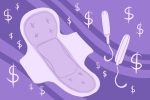The last year and a half has been difficult for innumerable reasons. Not the least of which was, of course, the COVID-19 pandemic. As people were forced to isolate themselves in their homes and transition to living life online, it felt like the world had come to a standstill. As everyone juggles many tasks, one thing has left nearly everyone’s mind: their posture.
The culprit is tech neck, also known as a good old slouch. As people spend all day working, relaxing and communicating on their devices, they’re constantly looking down and craning forward. This hunch, particularly sitting in it for the whole day, causes a change in the spine and a slouch when standing.
This is especially prevalent among college students. Most students were sent home — often to a different state and sometimes to a different country — and forced to interact with everything their school provides through their laptop screen. From classes to homework to readings to extracurriculars to socializing, everything these students were doing now happened online.
Getting Anatomical
When getting into the nitty-gritty of postural issues, it’s useful to think of muscles that are “locked long” and “locked short.” This isn’t referring to the actual length of the muscle, but how it is used. A “long” muscle is a muscle stretched more than it’s used, and a “short” muscle is a muscle used more than it is stretched. For example, if someone did bicep curls all day, their biceps would be “locked short” and their triceps at the back of their arms would be “locked long.”
In the neck, what is “long” and “short” is less obvious. Thankfully, the anatomy of a slouch is defined by Upper Crossed Syndrome. It states that a hunch is primarily caused by a tightness in the back of the neck and the front of the shoulders, and weakness in the front of the neck and the back of the shoulders.
Visually, Upper Crossed Syndrome isn’t obvious in the muscles but it is in the spine. An ideal spine follows an S-curve. Tech neck, however, causes the spine to droop at the neck. It also causes the vertebrae at the top of your spine to stick out, creating the “bump” felt when hunched.
The easiest way to tell if you have tech neck is to use what kinesiology calls a plumb line. Plumb lines are imaginary lines that define proper alignment; for example, look at your wrist. In a neutral position, the middle of the wrist makes a straight line with your middle finger. Therefore, there is a plumb line between the middle finger and the middle of the wrist.
Similarly, there are two points that should make a straight vertical line in the neck: the ear lobe and the middle of the shoulder. If your ear lobe is in front of your shoulder in your natural position, you have tech neck. And given the prevalence of both technology and slouching in the general population today, this will likely be the outcome for most people.
Should You Be Worried About Tech Neck?
The most obvious effects of bad posture are back pain and spine misalignment. If you’re forcing your neck into an unnatural position — by looking at a screen perhaps — you’re bound to feel pain or tension. Similarly, constantly looking down causes changes in the spine, resulting in misalignment.
Taking your spine out of alignment can affect other parts of the body too. Blood circulation, for example, is reduced due to bad posture as it causes less blood flow to and from the heart. Bad posture also compresses the lungs, decreasing their function. The stomach is also compressed with bad posture.
So, the short answer is maybe, but the long answer is more complex. It likely depends on how much time you spend online and how much time you spend doing activities to counteract these side effects. For example, if you spend all day working at a desk, then exercise for an hour a day, you’re likely doing enough to counter poor circulation, reduced lung function and digestive issues.
Hitting the Undo Button on Tech Neck
In terms of correcting posture, people actually have an intuitive sense of what to do, especially with an understanding of muscles being “long” or “short.”
We know that the upper back is stretched “long” in a slouch, so to reverse this, those muscles need to be strengthened. Any exercises that strengthen the trapezius and rotator cuff will get the job done. The simplest of these is to squeeze the shoulder blades together while sitting up straight, helping to train the shoulders to not slouch.
When muscles are “short,” like the front of the shoulders in a slouch, they need to be stretched. The main culprit in the shoulders causing a slouch is the pectoralis minor, which tightens and cups the shoulders forward. To stretch these, the classic doorway stretch is your best bet.
Reversing a slouch in the neck takes a little bit more nuance. If you ask someone to strengthen muscles in the front of their neck, most people won’t have any idea of what to do. There are two main options that can help strengthen these muscles. First, do a mini crunch with just the neck, and second, lace the fingers above the head and look up at them.
Stretching the back of the neck is more straightforward. One way to get a small stretch is to simply look down and let your head be heavy. To make this more efficient, you can put your hands on the back of your head to add weight. But be careful not to pull the neck — your arms are just adding a little extra weight and should rest on the head, not pull it.
The Big Picture
Tech neck isn’t the most detrimental effect of COVID-19 by a long shot, but it is something important to keep in mind that has an easy fix. It doesn’t take much to improve your posture; just gaining an awareness of when you are slouching is a start. Doing proper exercises like the ones described above is great, but consciously knowing when you are slouching and then correcting it makes a huge difference.
This is especially important for students who have spent the last few semesters online. The effects of bad posture are well recorded, and this generation of students is at a disadvantage. In order to fend off poor posture-induced issues post-COVID and beyond, students should start to correct their posture now.

















